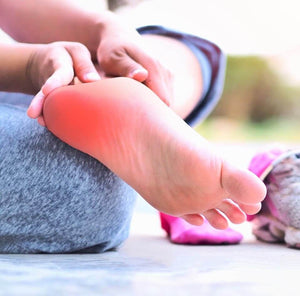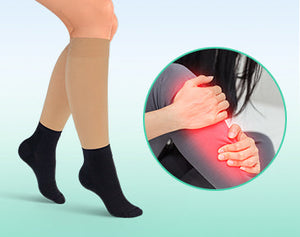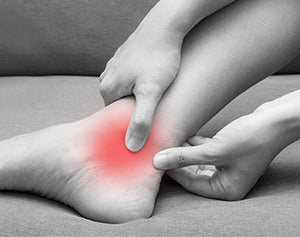The Orthofeet Blog
- All Posts
- Achilles Tendon Pain
- All
- Arch Support
- Arthritis
- Back Pain
- Bunions
- Diabetes
- Flat Feet
- Foot Pain
- Golf Shoes
- Hammer Toes
- Heel Pain
- Heel Pain/ Heel Spurs
- Knee & Hip Pain
- Knee pain
- Morton Neuroma
- Neuropathy
- Orthopedic shoes
- Other
- Overpronation
- Plantar Fasciitis
- Swollen Feet
Plantar Fasciitis


Josh White DPM / August 12, 2021
Hiking with Plantar Fasciitis: What You Need to Know
Hiking with Plantar Fasciitis: What You Need to Know
Read Post-
Foot Care for Elderly: How to Care for Aging Feet
Medical information provided by Orthofeet Team / July 29, 2025Developing a consistent daily routine for foot care at home is one of the most important steps you can take to maintain healthy feet. These simple habits can prevent many problems and help you identify issues early. Daily Care Tips Wash your feet thoroughly every day with warm (not hot) water and mild soap [4]. Pay special attention to cleaning between your toes, where moisture and bacteria can accumulate. After washing, dry your feet completely, especially between the toes, as moisture in these areas can lead to fungal infections. Apply moisturizer to keep skin soft and prevent cracking, but avoid putting lotion between your toes where excess moisture can cause problems [4]. Use a quality foot cream or lotion specifically designed for dry skin, and pay particular attention to your heels where cracking is most common. Inspect your feet daily for any changes, including cuts, bruises, swelling, redness, or changes in skin color [4]. Use a mirror if necessary to see the bottoms of your feet, or ask a family member to help if you have difficulty seeing all areas clearly. Look for any signs of infection, such as increased warmth, persistent redness, or discharge from cuts or sores. Early detection of problems allows for prompt treatment and prevents complications. Healthy Habits Elevate your feet regularly to reduce swelling and improve circulation. When sitting, prop your feet up on a footstool or ottoman so they're level with or slightly above your heart. Even 15-20 minutes of elevation several times throughout the day can help reduce fluid buildup. Perform gentle stretching and exercises to improve circulation and maintain flexibility [4]. Simple ankle rotations, calf raises, and toe wiggling can help keep blood flowing and joints moving, offering seniors a good way to promote foot health. These exercises are particularly important if you spend long periods sitting or lying down. Wear clean, moisture-wicking socks that keep your feet dry and comfortable [4]. Change socks daily, or more often if your feet tend to sweat. Choose socks made from materials that pull moisture away from your skin, and avoid socks with tight elastic bands that can restrict circulation. Keep your toenails trimmed straight across to prevent ingrown nails [4]. If you have difficulty reaching your feet or have vision problems, consider having a podiatrist or other healthcare provider trim your nails safely. When to Call a Doctor Consulting a specialized doctor can offer the best solutions for persistent issues. Certain signs and symptoms require prompt medical attention [4]. Any sign of infection, including persistent redness, warmth, swelling, or discharge from a wound, should be evaluated by a healthcare provider immediately. Persistent or worsening pain that interferes with walking or daily activities needs professional evaluation. Don't assume that foot pain is a normal part of aging that you must tolerate. Numbness, tingling, or burning sensations that don't improve may indicate nerve problems that require medical treatment. These symptoms are particularly concerning for people with diabetes or other conditions that affect circulation. Sudden or severe swelling, especially if it affects only one foot or is accompanied by pain, could indicate a serious condition requiring immediate care. Any wound that doesn't heal within a few days or shows signs of getting worse should be examined by a healthcare provider, especially if you have diabetes or circulation problems. Choosing the Right Footwear for Aging Feet Proper orthopedic shoes become increasingly important as your feet change with age. The right shoes can prevent many problems and provide the support and comfort your aging feet need. Must-Have Features Wide toe boxes give your toes adequate space and prevent pressure on bunions, hammertoes, or swollen areas. Shoes that squeeze your toes together can worsen existing deformities and create new problems over time. Adjustable closures such as Velcro straps, elastic laces, or multiple strap systems allow you to modify the fit as your feet change throughout the day [4]. This adjustability is particularly important if you experience swelling or have arthritis that makes traditional laces difficult to manage. Slip-resistant soles provide stability and reduce fall risk. Look for shoes with textured rubber soles that provide good traction on various surfaces, both wet and dry. Lightweight cushioning helps absorb impact and reduces stress on your joints. Quality cushioning in the heel and forefoot areas compensates for the natural loss of fat padding that occurs with age. Orthotic support helps maintain proper foot alignment and reduces strain on muscles and joints. Built-in arch support is particularly important if your feet have flattened over time or if you have conditions like plantar fasciitis. The Fit Factor Measure your feet regularly because aging feet often change in size and shape [2]. What fit perfectly a year ago may no longer be appropriate. Have your feet measured at least once a year, or whenever you notice your shoes feeling different. Shop for shoes in the afternoon or evening when your feet are slightly swollen to their largest size of the day. This ensures that shoes will be comfortable even when natural swelling occurs. Ensure shoes are snug but not tight. You should have about a thumb's width of space between your longest toe and the front of the shoe. The shoe should hold your foot securely without creating pressure points or allowing excessive movement. Look for adjustable features that accommodate daily changes in foot size due to swelling or stiffness. Shoes that can be loosened or tightened as needed provide better comfort throughout the day. Orthofeet Footwear Options for Elderly Foot Care At Orthofeet, we understand that how to care for aging feet includes choosing footwear designed specifically for the challenges that come with age. Our orthopedic shoes address the common problems that affect older adults while providing the comfort and support needed for daily activities. Our shoes feature premium orthotic insoles that provide targeted arch support and help maintain proper foot alignment. This support is crucial for people whose feet have changed shape over time or who have conditions like arthritis that affect foot function. Extra depth and wide-width options accommodate foot deformities, swelling, or the need for custom orthotics. Our designs ensure that people with bunions, hammertoes, or other age-related foot changes can find comfortable, supportive footwear. Cushioned, shock-absorbing soles help compensate for the natural loss of fat padding in aging feet. This cushioning reduces impact on joints and makes walking more comfortable on hard surfaces. Breathable, stretchable uppers adjust to your foot's shape and accommodate minor swelling that may occur throughout the day. These materials help prevent pressure points while providing a secure, comfortable fit. Easy-to-use closures make our shoes accessible for people with arthritis or limited mobility. Many of our styles feature Velcro straps, elastic laces, or other adjustable systems that don't require fine motor skills to operate. Our specialized collections include shoes for foot pain, shoes for swollen feet and edema, and orthopedic shoes for women and men’s orthopedic shoes. Taking proper care of your aging feet is an investment in your independence and quality of life. By understanding the changes that occur with age, developing consistent daily care habits, and choosing appropriate footwear, you can keep your feet healthy and comfortable for years to come. Remember that foot care for elderly individuals isn't just about treating problems after they develop. It's about preventing issues before they start and maintaining the mobility that allows you to continue enjoying the activities you love.[product-group-tile]================================Sources: [1] PubMed. "Foot care for the aging." 1987. https://pubmed.ncbi.nlm.nih.gov/3194453/ [2] PMC. "Foot Examination for Older Adults." 2021. https://pmc.ncbi.nlm.nih.gov/articles/PMC9614715/ [3] PubMed. "Foot disorders in the elderly: A mini-review." 2017. https://pubmed.ncbi.nlm.nih.gov/28826743/ [4] Emory Healthcare. "Foot Care for Seniors: 10 Important Tips." https://www.emoryhealthcare.org/stories/wellness/foot-care-for-seniors-10-important-tipsRead More -
Swollen Feet in Seniors: Causes and Solutions
Medical information provided by Orthofeet Team / July 29, 2025When you notice your shoes feeling tighter at the end of the day or your ankles looking puffier than usual, you're experiencing something that affects millions of older adults. Swollen feet in seniors is a common concern that goes beyond simple discomfort. It can signal underlying health issues and significantly impact mobility and quality of life. Understanding what causes swollen feet in seniors and knowing how to address this issue effectively can help you maintain your independence and comfort as you age. Let's explore the reasons behind foot swelling and discover practical solutions that can make a real difference in your daily life. Understanding Swollen Feet in Seniors Foot swelling, medically recognized as edema, happens when excess fluid accumulates in the tissues of your feet and ankles [1]. This swelling often affects elderly individuals. This fluid retention can range from mild puffiness that you barely notice to severe swelling that makes walking difficult and shoes impossible to wear and finding the right walking shoes for seniors even more important For seniors, swollen feet aren’t just a cosmetic concern. The swelling can create pressure points, increase fall risk, and indicate serious health conditions that require attention [2]. When fluid accumulates in your lower extremities, it can affect circulation, cause discomfort, and limit your ability to stay active. The goal isn't just temporary relief. It's understanding the root causes and implementing long-term strategies to prevent swelling while maintaining your mobility and comfort. Recognizing early signs and taking proactive steps can help you manage these common foot problems in older adults effectively. Common Causes of Swollen Feet in Seniors Several factors contribute to foot swelling as we age, and understanding these causes helps you address the problem more effectively. The most common cause of leg edema in older adults is chronic venous insufficiency, accounting for about 70% of cases [3]. Poor Circulation and Venous Insufficiency As we age, blood vessels naturally become less efficient at moving blood from from your ankles and feet back to the heart. This condition, called chronic venous insufficiency, occurs when the valves in your blood vessels wear down, allowing blood flow to slow [3]. This causes blood to pool in the lower legs and feet, leading to fluid buildup and swelling. When you sit or stand for extended periods, gravity makes this circulation problem worse. Your leg muscles, which normally help pump blood back up, aren't working as effectively when you're stationary. This is why many seniors notice their feet are more swollen at the end of the day or after long periods of inactivity, which helps explain why many older adults wonder, “Why do my feet hurt every day?”. Medication Side Effects Many medications commonly prescribed to seniors can cause fluid retention as a side effect [1]. These medications can lead to swollen ankles, exacerbating the condition in elderly patients. Blood pressure medications, particularly calcium channel blockers like amlodipine, can cause swelling in the ankles and feet [3]. Steroids, NSAIDs (non-steroidal anti-inflammatory drugs), and certain diabetes medications can also lead to fluid retention [1]. The tricky part about medication-related swelling is that it can develop gradually over time. You might not immediately connect your swollen feet to a medication you've been taking for months. If you notice new or worsening swelling after starting a new medication, it's important to discuss this with your doctor rather than stopping the medication on your own. Lifestyle Factors and Health Conditions Several lifestyle and health factors can contribute to swollen feet in seniors. A diet high in sodium causes your body to retain more water, which often shows up as swelling in your feet and ankles first [2]. Lack of movement, whether from a sedentary lifestyle or mobility limitations, reduces the natural muscle contractions that help move fluid back up your legs. Weight gain puts added pressure on the circulatory system, potentially leading to ankle swelling and making existing conditions, like swollen feet, worse. Medical conditions common in older adults can all cause fluid retention [1]. These include congestive heart failure, kidney disease, liver problems, and lymphedema. Kidney disease is particularly noteworthy for causing swelling. Arthritis can contribute to swelling around joints, while conditions affecting your lymphatic system can cause more persistent swelling that doesn't respond well to elevation. How Proper Footwear Can Help Reduce Swelling Many people don't realize that their shoes could be making foot swelling worse. Tight, rigid shoes restrict blood flow and can actually contribute to fluid buildup in your feet. When your shoes don't accommodate natural swelling that occurs throughout the day, they create pressure points that can worsen circulation problems, particularly in the ankles and feet. Orthopedic shoes designed specifically for swollen feet address these issues by providing features that support healthy circulation and accommodate changing foot size throughout the day. Proper health management includes selecting shoes that actively help manage swelling and prevent complications. It actively helps manage swelling and prevents complications. Wearing appropriate footwear is an essential care strategy for seniors. Wearing appropriate shoes for foot pain is an essential care strategy for seniors, explore Orthofeet’s collection of orthopedic shoes. Ideal Shoe Features for Swollen Feet When shopping for shoes to help with swollen feet, several key features make a significant difference in your comfort and the management of swelling. Extra Depth and Width allow room for swollen areas without creating pressure points. Unlike regular shoes that can become uncomfortably tight when your feet swell, shoes with extra depth provide the space your ankles and feet need while maintaining support and stability. Stretchable Uppers are particularly beneficial because they adjust to your foot's changing shape throughout the day. As natural swelling occurs, these materials expand to accommodate the changes without becoming loose or causing instability when the swelling reduces. Adjustable Closures like Velcro straps, elastic laces, or multiple strap systems let you modify the fit as needed. This adjustability is crucial for seniors whose feet may swell differently from day to day or who have difficulty with traditional laces due to arthritis or other mobility issues. Cushioned, Supportive Insoles reduce pressure on your feet and provide shock absorption that helps improve circulation. Quality insoles also help distribute your weight more evenly, reducing stress on particular areas that might be more prone to swelling. Seam-Free Interiors prevent friction and irritation, which is especially important when your feet are swollen and more sensitive to pressure and rubbing. Tips to Manage and Prevent Swollen Feet Beyond choosing the right footwear, several daily habits and routines can help you manage and prevent foot swelling. These strategies work best when used consistently and combined with appropriate footwear choices. At-Home Tips Elevate your feet regularly, especially after periods of standing or walking. When you're sitting, prop your feet up on a footstool or ottoman so they're level with or slightly above your heart [2]. Even 15-20 minutes of elevation several times a day can help reduce fluid buildup. Stay active with gentle exercises that promote circulation. Simple ankle rotations, calf raises, and short walks help your leg muscles pump fluid back up toward your heart, minimizing edema risks. Even light movement is better than remaining completely sedentary. Limit salty foods and stay hydrated with water rather than sugary or caffeinated drinks. High sodium intake causes your body to retain more fluid, while proper hydration actually helps your body process and eliminate excess fluids more effectively [2]. Wear compression socks if recommended by your doctor. These specially designed stockings apply gentle pressure to help improve circulation and reduce swelling [2]. Make sure to get the right size and compression level for your specific needs. Footwear Habits Don't walk barefoot or in unsupportive shoes, even indoors. Your feet need consistent support throughout the day to maintain proper circulation and prevent swelling from worsening. Measure your feet regularly because swelling can affect your shoe size over time. What fit perfectly six months ago might now be too tight and contribute to circulation problems. Choose shoes that can adjust throughout the day to accommodate natural changes in foot size. Shoes with flexible materials and adjustable closures help ensure comfort whenever ankles and feet swell, either in the morning or most swollen in the evening. When to See a Doctor While mild, occasional swelling is often manageable with lifestyle changes and proper footwear, some signs require immediate medical attention [2]. Sudden or severe swelling that appears quickly or affects only one foot or leg could indicate a serious condition like a blood clot. Swelling accompanied by pain, redness, or warmth might signal an infection or other condition that needs prompt treatment. Persistent swelling that doesn't improve with elevation or gets worse over time should also be evaluated by a healthcare provider. Don't hesitate to seek medical guidance if you're concerned about your symptoms. Early intervention can prevent complications and help you maintain your mobility and independence. Orthofeet Shoes Designed for Swollen Feet At Orthofeet, we understand the unique challenges that swollen feet present for seniors. Our shoes are specifically designed to address the causes and complications of foot swelling while providing the comfort and support you need to stay active. Key Features of Orthofeet Footwear Extra-depth and wide-fit options provide the roomy designs necessary to relieve pressure on swollen areas. Our shoes give your feet the space they need without sacrificing stability or support, making them some of the best shoes for seniors with balance problems to help maintain balance and comfort. Premium orthotic insoles offer targeted support and cushioning that reduces foot fatigue and improves circulation. These insoles are designed to distribute pressure evenly across your foot, reducing stress on areas prone to swelling. Pairing these with quality orthopedic shoes for men or orthopedic shoes for women can further enhance foot health and comfort. Adjustable stretchable uppers conform to your foot's shape without squeezing or restricting circulation. As your feet change throughout the day, our shoes adapt to provide consistent comfort. Ergonomic soles improve your gait and reduce impact with every step. This design helps promote better circulation and reduces the strain that can contribute to swelling. Diabetic and arthritis-friendly models are specifically designed for seniors with sensitive feet or conditions that increase the risk of complications from swelling and poor circulation. Our shoes for swollen feet and edema collection includes options for both men's shoes for swollen feet and women's shoes for swollen feet, ensuring that everyone can find the right solution for their needs. Don't let swollen feet limit your mobility or comfort. With the right understanding, daily care habits, and properly designed footwear, you can manage this common issue and maintain an active, independent lifestyle. [product-group-tile] =========================================== Sources: [1] Mayo Clinic. "Edema - Symptoms and causes." Mayo Clinic, July 28, 2023. https://www.mayoclinic.org/diseases-conditions/edema/symptoms-causes/syc-20366493 [2] Mayo Clinic News Network. "Mayo Clinic Q and A: Mild leg swelling should be evaluated." December 26, 2017. https://newsnetwork.mayoclinic.org/discussion/mayo-clinic-q-and-a-mild-leg-swelling-should-be-evaluated/ [3] Cadense. "What Causes Swollen Feet in the Elderly?" January 1, 2024. https://cadense.com/blogs/cadense-cares/what-causes-swollen-ankles-in-elderlyRead More -
6 Tips to Treat Swollen Feet from Diabetes
Medical information provided by Orthofeet Team / January 23, 2025Discover the best ways to manage and treat swollen feet caused by diabetes. Learn effective solutions, including proper footwear, elevation, and more.Read More







